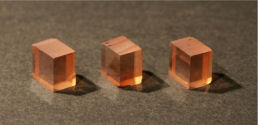solid matter
To distinguish between solid and soft matter, we define solid matter in the following way: substances that possess a crystalline or amorphous structure and are considered as „solids in the classical definition“ are solid matter. Typical representatives that are employed in our research group are photorefractive crystals and fused silica.
Photorefractive crystals
Photoconductivity and the electro-optic effect are the crucial properties for an inorganic crystal to provide light-induce refractive index changes, i.e., to be photorefractive. Typically, these electro-optic crystals are employed for frequency filtering in the field of mobile communications as so-called surface acoustic wave (SAW) filters or as electro-optic modulators. Additionally, photorefractive crystals are applied as wavelength filters for telecommunications in so-called division wavelength demultiplexers (DWDMs).

Lithium niobate
A typical photorefractive material for experiments in the field of nonlinear optics is lithium niobate. Its crystal structure is uniaxial and it possesses ferroelectric, piezoelectric, pyroelectric, birefringent, and optically nonlinear properties. Advanced crystal growth techniques such as the Czochralski technique allow for fabrication of single crystals in large dimension and outstanding optical quality. In our group, we employ lithium niobate in the fields of fs direct laser-writing and microfluidics. The disadvantage of inorganic materials such as lithium niobate is its comparably low sensitivity compared to photopolymers and their instability or rather reversibility of the refractive index grating during continuous readout.

